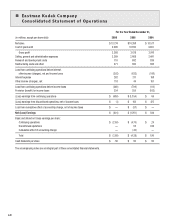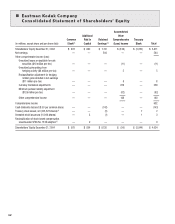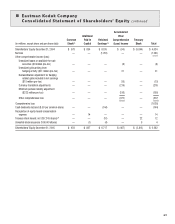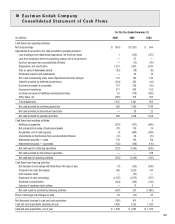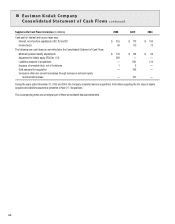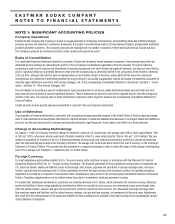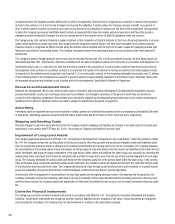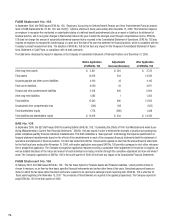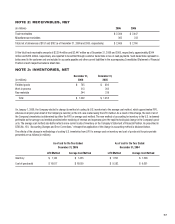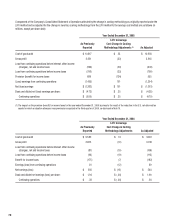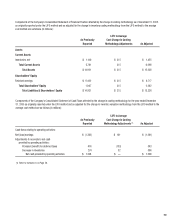Kodak 2006 Annual Report Download - page 77
Download and view the complete annual report
Please find page 77 of the 2006 Kodak annual report below. You can navigate through the pages in the report by either clicking on the pages listed below, or by using the keyword search tool below to find specific information within the annual report.0
In instances where the Company provides slotting fees or similar arrangements, this incentive is recognized as a reduction in revenue when payment
is made to the customer (or at the time the Company has incurred the obligation, if earlier) unless the Company receives a benefit over a period of
time, in which case the incentive is recorded as an asset and is amortized as a reduction of revenue over the term of the arrangement. Arrangements
in which the Company receives an identifiable benefit include arrangements that have enforceable exclusivity provisions and those that provide a
clawback provision entitling the Company to a pro rata reimbursement if the customer does not fulfill its obligations under the contract.
The Company may offer customer financing to assist customers in their acquisition of Kodak’s products. At the time a financing transaction is consum-
mated, which qualifies as a sales-type lease, the Company records equipment revenue equal to the total lease receivable net of unearned income.
Unearned income is recognized as finance income using the effective interest method over the term of the lease. Leases not qualifying as sales-type
leases are accounted for as operating leases. The Company recognizes revenue from operating leases on an accrual basis as the rental payments
become due.
The Company’s sales of tangible products are the only class of revenues that exceeds 10% of total consolidated net sales. All other sales classes are
individually less than 10%, and therefore, have been combined with the sales of tangible products on the same line in accordance with Regulation S-X.
Incremental direct costs (i.e. costs that vary with and are directly related to the acquisition of a contract which would not have been incurred but for
the acquisition of the contract) of a customer contract in a transaction that results in the deferral of revenue are deferred and netted against revenue
in proportion to the related revenue recognized in each period if: (1) an enforceable contract for the remaining deliverable items exists; and (2) delivery
of the remaining items in the arrangement is expected to generate positive margins allowing realization of the deferred costs. Otherwise, these costs
are expensed as incurred and included in cost of goods sold in the accompanying Consolidated Statement of Operations.
Research and Development Costs
Research and development (R&D) costs, which include costs in connection with new product development, fundamental and exploratory research,
process improvement, product use technology and product accreditation, are charged to operations in the period in which they are incurred. In
connection with a business combination, the purchase price allocated to research and development projects that have not yet reached technological
feasibility and for which no alternative future use exists is charged to operations in the period of acquisition.
Advertising
Advertising costs are expensed as incurred and included in selling, general and administrative expenses in the accompanying Consolidated Statement
of Operations. Advertising expenses amounted to $394 million, $490 million and $513 million in 2006, 2005 and 2004, respectively.
Shipping and Handling Costs
Amounts charged to customers and costs incurred by the Company related to shipping and handling are included in net sales and cost of goods sold,
respectively, in accordance with EITF Issue No. 00-10, “Accounting for Shipping and Handling Fees and Costs.”
Impairment of Long-Lived Assets
The Company applies the provisions of SFAS No. 144, “Accounting for the Impairment or Disposal of Long-Lived Assets.” Under the guidance of SFAS
No. 144, the Company reviews the carrying values of its long-lived assets, other than goodwill and purchased intangible assets with indefinite useful
lives, for impairment whenever events or changes in circumstances indicate that the carrying values may not be recoverable. The Company assesses
the recoverability of the carrying values of long-lived assets by first grouping its long-lived assets with other assets and liabilities at the lowest level for
which identifiable cash flows are largely independent of the cash flows of other assets and liabilities (the asset group) and, secondly, by estimating the
undiscounted future cash flows that are directly associated with and that are expected to arise from the use of and eventual disposition of such asset
group. The Company estimates the undiscounted cash flows over the remaining useful life of the primary asset within the asset group. If the carrying
value of the asset group exceeds the estimated undiscounted cash flows, the Company records an impairment charge to the extent the carrying value
of the long-lived asset exceeds its fair value. The Company determines fair value through quoted market prices in active markets or, if quoted market
prices are unavailable, through the performance of internal analyses of discounted cash flows or external appraisals.
In connection with its assessment of recoverability of its long-lived assets and its ongoing strategic review of the business and its operations, the
Company continually reviews the remaining useful lives of its long-lived assets. If this review indicates that the remaining useful life of the long-lived
asset has been reduced, the Company adjusts the depreciation on that asset to facilitate full cost recovery over its revised estimated remaining useful
life.
Derivative Financial Instruments
The Company accounts for derivative financial instruments in accordance with SFAS No. 133, “Accounting for Derivative Instruments and Hedging
Activities.” All derivative instruments are recognized as either assets or liabilities and are measured at fair value. Certain derivatives are designated
and accounted for as hedges. The Company does not use derivatives for trading or other speculative purposes.


